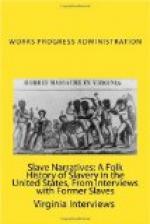Ketch a live scorpen wid you han’,
Hoo-doo;
Drown in mare’s milk in a pan, Hoo-doo;
Den dry it on a pure lime rock,
Ninety-nine minutes by de clock, Hoo-doo.
Den git a hand which is a bag, Hoo-doo;
Made uv any sort uv rag, Hoo-doo;
An’ let de top be color’d
blue,
Den git de hair frum out de shoe, Hoo-doo.
Now we’n you find de folks ain’t
well, Hoo-doo;
An’ dey wants you to move de spell,
Hoo-doo;
Git your gredients together,
Ster dem up wid a goose feather,
In sum dark an’ cloudy weather,
Hoo-doo.
Den put ’em in de hoo-doo bag, Hoo-doo;
In dat little blue top rag, Hoo-doo;
Den slip ’em in between de ticks,
Ef you want de conjure fixed,
Is de way you do de tricks, Hoo-doo.
Ef dey wants you to git ’em well,
Hoo-doo;
Dat is de han’ dat moves de spell,
Hoo-doo;
Take it out before der eyes,
An’ you mus’ be awful s’prised,
And dey will think dat you is wise, Hoo-doo.
Den lay right down on your back, Hoo-doo;
Ef you hear de timbers crack, Hoo-doo;
Den yer kno’s yer trick has won,
Den you’ll ast er-bout de mon,
For you kno’s yer work is done,
Hoo-doo.
Now ef you wants de conjure fixt, Hoo-doo;
All you do is to turn de tricks, Hoo-doo;
Jes git dat bottle what you had,
An’ to make your patient glad,
Is but to make de conjurer mad, Hoo-doo.
Hopkins Co.
(M. Hanberry) [TR: also spelled Hanbery.]
In this county practically no one owned more than one or two slaves as this was never a county of large plantations and large homes. These slaves were well housed, in cabins, well clothed and well fed, not overworked and seldom sold, were in closer touch with the “white folks” and therefore more intelligent than farther south where slaves lived in quarters and seldom came in contact with their masters or the masters’ families. When a gentleman wished a slave he usually went to Hopkinsville and bought slaves there. Occasionally one slave owner would buy one from another. “If there was ever a slave market in Madisonville or Hopkins County I do not remember it or ever heard of it,” says J.M. Adams, book-keeper of Harlen Coal Company, age 84, Madisonville, Ky.
In the year 1864, during the conflict between the North and South, a new citizen was added to the town of Warfield. His name was Alfred Richardson, a colored man. Heretofore the people would not permit negroes to live in Warfield.
Richardson was in a skirmish at Warfield and was listed among the northern people as missing. His leg was injured and he was in a serious condition. The good people living at Warfield had their sympathies stirred up by his condition and took him in and gave him food and medical attention until he was able to work.




